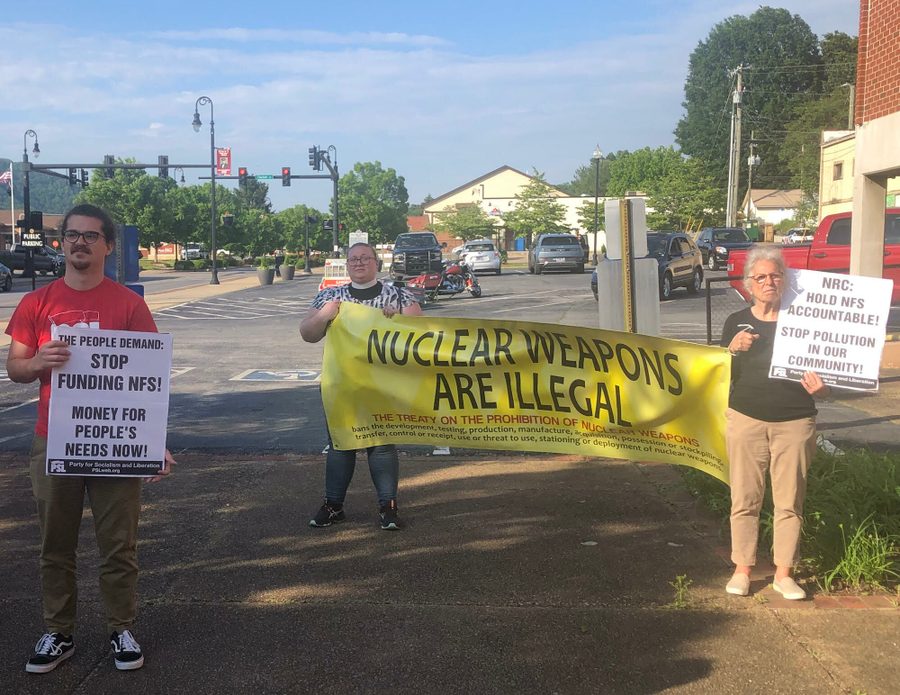In Small Town Appalachia, Locals Battle a Weapons-Grade Uranium Plant
The company Nuclear Fuel Services wants to process weapons-grade uranium for the U.S. government at a facility in Erwin, Tennessee. Some locals aren’t having it.
Taylor Sisk

ERWIN, TENN. — Barbara O’Neal has deep roots in Erwin, a town of 6,000 cradled in the Blue Ridge Mountains near the North Carolina border. She left for a career with the Department of Defense but returned after 40 years to care for her mom. In 2004, O’Neal settled down on a piece of land that had been in her family for more than a hundred years and built her dream house, complete with a panoramic view of the mountains.
Unfortunately for O’Neal, the house is also just up the road from a plant operated by Nuclear Fuel Services (NFS) that handles uranium and plutonium.
O’Neal learned that nine gallons of highly enriched uranium had spilled on the shop floor in March 2006 — one in a series of apparent violations that the Nuclear Regulatory Commission blamed in part on the company’s “deficient safety culture.”
The spill led O’Neal to dig into the history of safety violations at NFS. Among O’Neal’s findings: In 2009, an “unexpected” chemical reaction triggered a release of nitrogen, which caused the company to shut down the plant for months and pay a civil penalty of $140,000.
NFS, a subsidiary of BWX Technologies, has processed uranium at its Erwin facility since 1959, including making fuel for Navy submarines and aircraft carriers.
In April, the National Nuclear Security Administration (NNSA) awarded NFS a $428 million contract to start processing highly enriched, weapons-grade uranium. According to Defense Daily, the NNSA needs uranium for “refurbished nuclear warheads and bombs.” The Biden administration has opted to continue a $355 billion Trump administration plan to “modernize” the nuclear weapons arsenal.
O’Neal now serves as vice president of the Erwin Citizens Awareness Network (ECAN), a local environmental group that fiercely opposes the planned uranium processing. She says the facility is too close to homes, schools and businesses, and that the company should not be trusted to prevent contamination to the soil, water and air.
According to Terry Lodge, ECAN’s lawyer, the plan “essentially doubles” the amount of highly enriched uranium handled at the plant, increasing the chances of a serious nuclear accident.
Moreover, ECAN President Linda Modica worries about the process the company plans to use; according to the contract announcement, this process is not even used at the NNSA’s major nuclear facility at Oak Ridge, Tenn.
The plan, Modica says, would subject the people of southern Appalachia “to experimentation on our lives, on our water supply, on places where we live, the land that we grow our vegetables on.” But ECAN’s objections go beyond the threat to their local environment.
“We know that the Department of Energy and the Department of Defense have more nuclear weapons than they can possibly use,” she says. “And, of course, that a nuclear war cannot be won and must never be fought.”
NFS has applied with the Nuclear Regulatory Commission (NRC) for an amended permit for its Erwin facility. In October, the NRC ruled against ECAN’s attempt to intervene in the permitting process.
New research gives residents even more cause for concern.
Michael Ketterer, a professor emeritus of chemistry and biochemistry at Northern Arizona University who used to work for the Environmental Protection Agency’s Office of Enforcement, has studied the Erwin area and found uranium contamination in the Nolichucky River near the facility and downstream in Davy Crockett Lake. In May, Ketterer examined dust from the attic of a home in Erwin and found uranium pollution there too. Environmental contamination, Ketterer concluded in a letter to residents, “has been slowly taking place and accumulating over decades of plant operation.”
In June, Joseph Mangano, of the Radiation and Public Health Project, issued the results of a study of mortality rates in Unicoi County, where Erwin is located. Until the late 1990s, according to the study, the county’s all-cause death rate was roughly equal to that of the country but has since climbed 44% above the U.S. rate. A factor driving the increase, according to the study, is the county’s cancer death rate, which has climbed 39% above the U.S. rate since the early 1990s.
David Gasperson, a public affairs officer for the Nuclear Regulatory Commission, says the Radiation and Public Health Project has yet to back the study with peer-reviewed evidence.
The study “does not establish a ‘link’ between NFS and cancer or disease rates in Unicoi County,” Gasperson says in an email response to questions. “Instead, it says ‘some factor or factors’ must account for those rates being higher than average and then points out that a nuclear facility operates in the county.”
NFS declined to comment for this article.
O’Neal, for her part, continues to monitor NFS violations, but from a safer distance. After weighing the threat posed by the nearby nuclear facility, O’Neal left her dream house on the family land in Erwin in 2012 and moved about 15 miles north, to Johnson City.
Taylor Sisk is an Appalachia-focused health care reporter whose work primarily explores how policies and practices affect people’s lives.





